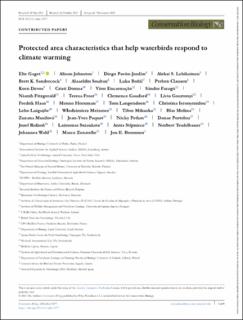Protected area characteristics that help waterbirds respond to climate warming
Gaget, Elie; Johnston, Alison; Pavòn-Jordàn, Diego; Lehikoinen, Aleksi S.; Sandercock, Brett; Soultan, Alaaeldin; Božič, Luka; Clausen, Preben; Devos, Koen; Domsa, Cristi; Encarnaçao, Vitor; Faragó, Sándor; Fitzgerald, Niamh; Frost, Teresa; Gaudard, Clemence; Gosztonyi, Lívia; Haas, Fredrik; Hornman, Menno; Langendoen, Tom; Ieronymidou, Christina; Luigujõe, Leho; Meissner, Włodzimierz; Mikuska, Tibor; Molina, Blas; Musilova, Zuzana; Paquet, Jean-Yves; Petkov, Nicky; Portolou, Danae; Ridzoň, Jozef; Sniauksta, Laimonas; Stīpniece, Antra; Teufelbauer, Norbert; Wahl, Johannes; Zenatello, Marco; Brommer, Jon E.
Peer reviewed, Journal article
Published version

Åpne
Permanent lenke
https://hdl.handle.net/11250/3036677Utgivelsesdato
2021Metadata
Vis full innførselSamlinger
- Publikasjoner fra CRIStin - NINA [2364]
- Scientific publications [1392]
Originalversjon
10.1111/cobi.13877Sammendrag
Protected area networks help species respond to climate warming. However, the contribu-tion of a site’s environmental and conservation-relevant characteristics to these responsesis not well understood. We investigated how composition of nonbreeding waterbird com-munities (97 species) in the European Union Natura 2000 (N2K) network (3018 sites)changed in response to increases in temperature over 25 years in 26 European countries.We measured community reshuffling based on abundance time series collected under theInternational Waterbird Census relative to N2K sites’ conservation targets, funding, des-ignation period, and management plan status. Waterbird community composition in sitesexplicitly designated to protect them and with management plans changed more quickly inresponse to climate warming than in other N2K sites. Temporal community changes werenot affected by the designation period despite greater exposure to temperature increaseinside late-designated N2K sites. Sites funded under the LIFE program had lower climate-driven community changes than sites that did not received LIFE funding. Our findingsimply that efficient conservation policy that helps waterbird communities respond to cli-mate warming is associated with sites specifically managed for waterbirds.KEYWORDSclimate adaptation, colonization, conservation policy, distribution change, EU Birds Directive, LIFE program,wetland
